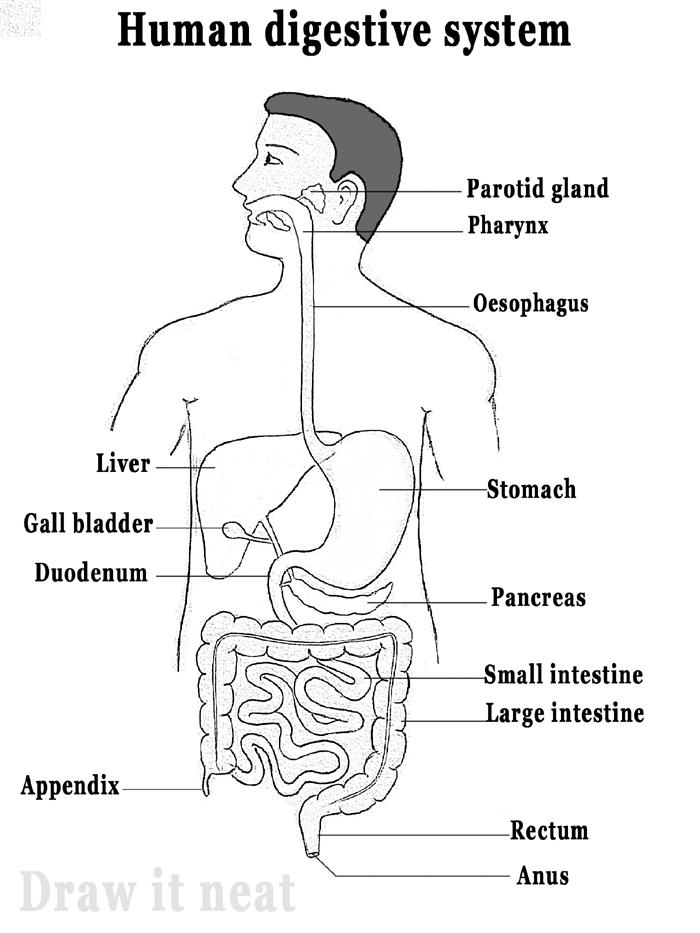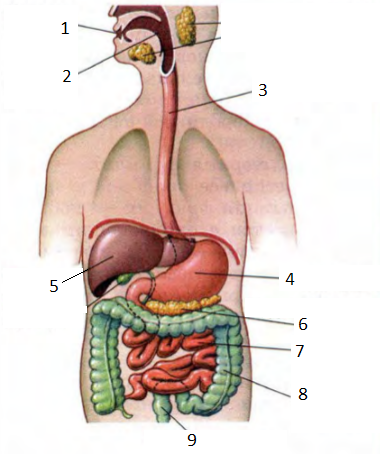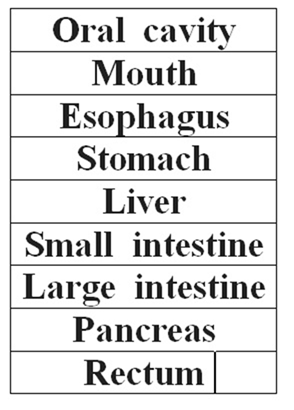Yegorova Natali
Atyrau city
Lesson plan
| Subject | Biology |
| Lesson Topic | The structure of the human digestive system |
| Class | 8 |
| Date | The 9-th of June |
| Objectives of the lesson: | 1. Students know the structure of the human digestive system 2. Students explain the biological significance of the human digestive system |
| Language objectives of the lesson:
| 1. Students know and use the following words and terms: digestive system, oral cavity, mouth, teeth, pharynx, esophagus, stomach, duodenum, small intestine, large intestine, pancreas, liver, gall bladder, rectum, anus (пищеварительная система, ротовая полость, рот, зубы, глотка, пищевод, желудок, двенадцатиперстная кишка, тонкий кишечник, толстый кишечник, поджелудочная железа, печень, желчный пузырь, прямая кишка) 2. Students know and use expressions: X consists of ... (Х состоит из...) |
| Required equipment and devices | Computer, projector, presentation, cards with text and pictures |
| Additional Resources | 1. Video: «The Digestive system» (https://www.youtube.com/watch?v=JnzwbipJuAA); 2. en.wikipedia.org/wiki/Human_digestive_system |
| The course of the lesson | |
| Stages of the lesson | Lesson Processes |
| Stage 1 Greeting and checking for student missing | Good afternoon, students. What is the date today? Who is absent today? |
| Stage 2 Activating previous knowledge | 1. What are the main types of human tissues? (Epithelial, connective, muscular, nervous) 2. Which muscle in the human body is the largest? (Large gluteal) 3. Which bone in the skeleton is the longest? (Femur) 4. Where are the smallest human bones? (In the ear) 5. How many percent of water does the bone contain? (Up to 22%) 6. How many muscles are in the human body? (More than 600) 7. What is the area of the respiratory surface of the lungs? (More than 90 square meters) 8. What kind of blood cells exist? (Erythrocytes, leukocytes, platelets) 9. How many bones are there in the human skeleton? (More than 200) 10. What is the average length of all human vessels? (Approximately 100,000 km) 11. How many neurons does the human nervous system contain? (More than 10 billion) 12. What is the area of the human skin? (About 2 square meters) |
| Stage 3 Read the expression and translate
| Are we living to eat or eat to live? (Мы живем, чтобы есть или едим, чтобы жить?) What do you think, what will we talk about?
The theme of our lesson: The structure of the human digestive system |
| Stage 3 Watch a video | Video: The digestive system |
| Stage 4 Read the text, compare with the picture and insert the missing terms. Translate the text | esophagus oral cavity stomach tongue pharynx small intestine liver
What is the human digestive system? These are the digestive organs that provide the body with various vitamins, substances and energy. All this is very necessary for human life. The digestive tract consists of organs through which food passes. The length of the canal is about 8-10 meters. It begins with the 1___________. The oral cavity consists of salivary glands, 2__________ and teeth. Here, the food is crushed and sent through the 3______________ into the 4________________. Then the food gets into the 5 ______________. After in the duodenum, 6________________ and large intestine. Undigested food enters the rectum and is removed through the anus. The digestive process is helped by other organs: salivary glands, 7_____________, gall bladder, pancreas. Check yourself: 1. oral cavity 2. tongue 3. pharynx 4. esophagus 5. stomach 6. small intestine 7. liver |
| Stage 5 Read the text and decide if the sentences are true (T) or false (F)/ Correct the false sentences. | So, what do we need a digestive system?
1. There is an esophagus in front of the stomach (T) 2. The length of the digestive tract is 3-5 meters (F) 3. The small intestine enters the digestive tract (T) 4. The stomach is in front of the rectum (F) 5. Behind the esophagus is the small intestine (F) |
| Stage 6 Repeat after me | digestive system, mouth, teeth, pharynx, esophagus, stomach, duodenum, small intestine, large intestine, pancreas, liver, gall bladder, rectum, anus |
| Stage 7 Choose terms to these pictures
|
|
| Stage 8 Homework: Make a crossword (use new terms) | The structure of the human digestive system |
ATTACHMENT
Text for students
esophagus oral cavity stomach tongue pharynx small intestine liver
What is the human digestive system? These are the digestive organs that provide the body with various vitamins, substances and energy. All this is very necessary for human life.
The digestive tract consists of organs through which food passes. The length of the canal is about 8-10 meters. It begins with the 1___________. The oral cavity consists of salivary glands, 2__________ and teeth. Here, the food is crushed and sent through the 3______________ into the 4________________.
Then the food gets into the 5 ______________. After in the duodenum, 6________________ and large intestine. Undigested food enters the rectum and is removed through the anus.
The digestive process is helped by other organs: salivary glands, 7_____________, gall bladder, pancreas.




 Получите свидетельство
Получите свидетельство Вход
Вход












 Строение пищеварительной системы человека Урок на английском языке (515.5 KB)
Строение пищеварительной системы человека Урок на английском языке (515.5 KB)
 0
0 2840
2840 46
46 Нравится
0
Нравится
0


